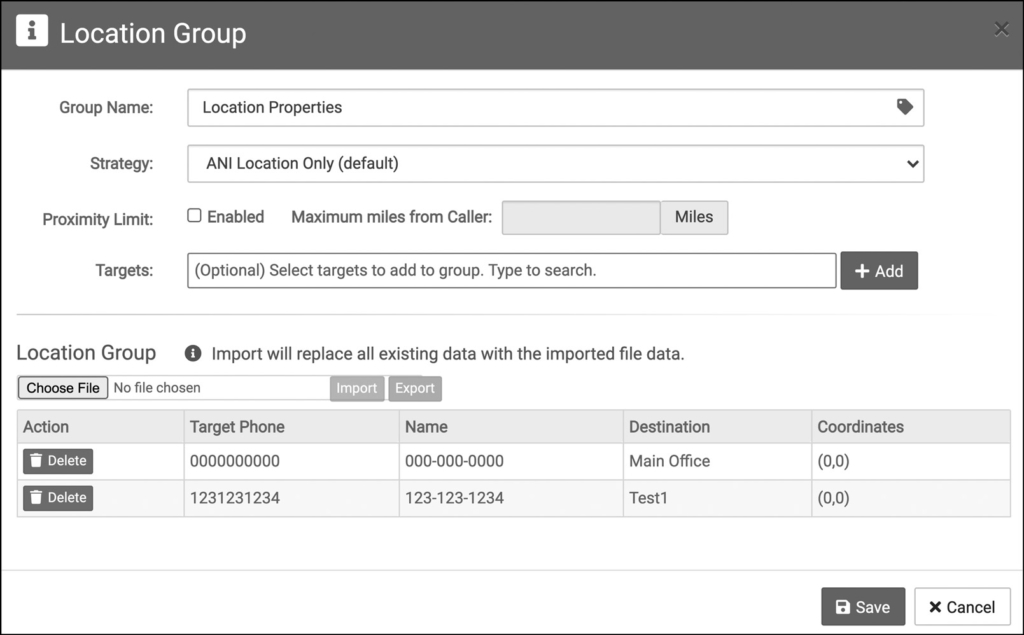This article explains the settings and customizable options for each type of group in Accuroute®. For help setting up a group, check out the Creating and Managing Groups article.
How do Routing Groups Work?
Within AccuRoute, routing profiles define the flow of logic and prompts that an inbound call will progress through to get to a target location (the phone number, or numbers, you want to route the call to).
Groups are a list of targets that have a specific type of routing logic associated with them. When a call is routed to a group, that group’s routing logic is executed, and the call is sent to a target in the group as determined by that group’s routing logic.
Hunt Group Properties
Hunt groups contain a list of targets in an explicitly defined order of priority. Routing a call to a hunt group will attempt to send the call to targets in that priority order until the call is connected.

Distribution Mode
For hunt groups, this must always best set to Hunt.
Group Name
The name you give your hunt group.
Ring-No-Answer
The amount of time, measured in seconds, that AccuRoute attempts to connect the call to each target before moving on to the next target in the hunt group if there is no answer.
Repeat Max
The maximum number of times AccuRoute will cycle through the hunt group attempting to connect the call.
Repeat Message
An audio file you create that will play between each cycle of the hunt group. For example, a recording that says “please stay on the line, your call is very important to us.”
Repeat messages are an optional feature.
Targets
The list of targets, or agents, included in this group.
Uniform Group Properties
Uniform Groups contain a list of targets to which calls are evenly distributed.

Distribution Mode
For uniform groups, this must always be set to Uniform.
Group Name
The name you give your hunt group.
Targets
The list of targets, or agents, included in this group.
Simultaneous Ring Group Properties
Simultaneous ring groups contain a list of targets in no specific order that all ring at the same time when an inbound call comes in.

Distribution mode
For a simultaneous ring group, this must always be set to Simultaneous Ring.
Group Name
The name you give your hunt group.
Ring-No-Answer
The amount of time, measured in seconds, that a call can ring a target before abandoning the call.
Do note that this value overrides the ring-no-answer attribute on the inbound number property. The ring-no-answer property of individual targets in this group also do not apply.
Targets
The list of targets, or agents, included in this group.
Percent Allocation Group Properties
Percentage allocation groups contain a list of targets to which calls are distributed based on a percentage allocated per target. The total percentages must add up to 100, but otherwise you can distribute them however you want – this includes equally among everyone or weighing some targets more than others.

Group Name
The name you give your hunt group.
Targets
The list of targets, or agents, included in this group.
Territory Group Properties
Territory groups contain a list of targets in no specific order with territories assigned to them, such as zip or area codes.

Group Name
The name you give your hunt group.
Implied NPANXX
If this option is enabled, the area code and exchange of the caller’s ANI (the caller’s phone number) will be used if they were not prompted to enter it in.
Implied Postal Code
If this option is enabled, the zip code associated with any caller’s ANI (the caller’s phone number) will be used for target group routing if they were not prompted to enter it in.
Targets
The list of targets, or agents, included in this group.
Location Group Properties
Location groups contain a list of targets, in no specific order, that include a latitude and longitude for each defining where a call should be routed based on their calculated distance from the caller. This is often used to send a call to the nearest office when a business has multiple locations.

Group Name
The name you give your hunt group.
Strategy
There are four ways you can set up a location group:
- ANI Location Only – select the target closest to the location of the caller’s ANI (caller ID)
- ZipCode Location Only – select the target closest to the location of the zip code of the caller (you must prompt the caller to enter their zip code first)
- ANI Location Then ZipCode Location – first try to select the target closest to the location of the caller’s ANI, then choose a target based on zip code if the caller’s location cannot be determined
- ZipCode Location Then ANI Location – first try to select the target closest to the caller’s zip code, and then if the zip code is not found or not provided choose a target based on the location of the caller’s ANI
Proximity Limit
When proximity limit is enabled, a call will only be delivered to a target if the caller is within a predefined area.
Maximum Miles
The maximum distance, measured in miles, that a caller may be from a target in order to be considered for routing.
Targets
The list of targets, or agents, included in this group.
You now have a better understanding of groups and can set up your routing groups in AccuRoute.


